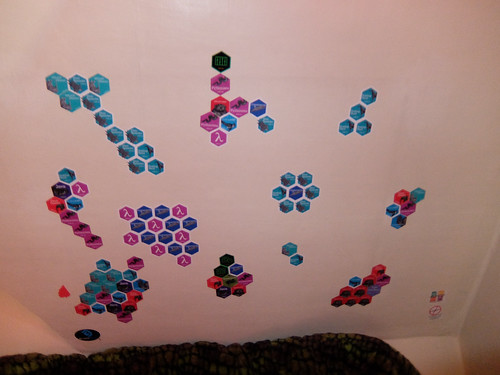I've grown in both my respect and understanding for several historical figures in recent years, Descartes and Mercator in particular. Both had to navigate in the treacherous waters of fear, based in strife among namespaces. Religious wars were rampant in other words.
Mercator ended up in jail for a spell, whereas Descartes was always dodging the equivalent of paparazzi and may have been poisoned in the end, as chief adviser to a Scandinavian Queen. Copernicus was also cool.
Johannes Kepler, however, I'd come to appreciate much earlier, through Arthur Koestler's works. Here was a guy really into the classic rhombic dodecahedron, a space-filling shape. He understood its connection to what we today call the CCP or FCC matrix, both with the word "cubic" in them, yet 60-degree and 120-degree angles are what stand out given balls closest-pack in triangular relationships as much as square.
The growing cuboctahedron of dense-packed spheres that defines the CCP is actually the dual shape to the rhombic dodecahedron, the shape which naturally encases each of those spheres such that they become inter-tangent at the centers of its twelve diamond faces.
:: Growth of the IVM (= fcc, = ccp) ::
Thanks to graphene and the emergence of the Age of Carbon as some call it, hexagonal awareness has surged to the foreground, with checker-board patterns (except Chinese) receding, though also present in the CCP in cross-section.
The discovery of buckminsterfullerene as an allotrope of carbon in the 1980s marked the beginning of a cascade of events, leading to nano-tubes and then graphene. The computer industry has converged to this space of hexagons, and, by extension, the rhombic dodecahedra so fascinating to Kepler.
On to Aristotle, who fits in for his controversial claim that tetrahedrons are space-filling. Regular ones are clearly not, so is that what he meant?
Rather than put words in Aristotle's mouth, or take them out, we should simply remember the MITE or Minimum Tetrahedron, as a component of Kepler's rhombic dodecahedron. Crisscross each diamond face and pull out the four right angle tetrahedrons.
These Mites also form cubes in assemblies of 24, and the space-filling Coupler (= 8 Mites), an oblate octahedron.
That "Coupler" rhymes with "Kepler", at least a little, helps hold this memeplex together.
The MITE is space-filling, in other words, as are some of the Sytes built from them. The quarter Rite (also space-filling) is yet another. None of these have "handedness" and so qualify as Sommerville Tetrahedrons, named for the geometer who studied them.
What Glenn Stockton calls the Global Matrix includes concentric hexapents, like carbon cages of arbitrary frequency, as a data store and display structure. Such layering for mapping purposes is consistent with other geometry learned from dividing spheres.
Shifting education channels to help bring these patterns forward into more common everyday awareness could mean putting more emphasis on both Kepler and Aristotle for the reasons mentioned.
When it comes to memes and memetics, the core metaphor is: "connecting the dots" -- the stuff of graph theory and graph databases.

